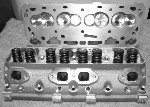Cylinder heads don't work on any one function. I guess you can break a cylinder heads performance down into about 4 main functions. They are related though.
1. Airflow: Everyones favorite, Its measurable, its easy to throw out a number during a bench racing session, and there is math to project power levels of a given cfm. Based on a particular efficiency. When the efficiency changes the math changes.
2. Velocity: This is a good indicator of incoming port energy, this must be backed by a cfm number relative to the power level you are looking achieve to have truly have energy. One without the other doesn't work.
3. Efficiency: This is where you start to here crickets. This where all the magic is. The secrets. The heads that make high horsepower and torque. The ability to handle high amounts of compression, on minimal octane.
4. Valve train: It seems a little out of place with the others. But if it is not up to task than the rest is a waste of time.
Others may disagree, but the old hemi's of the 50's and 60's weren't really exciting naturally aspirated. I do feel that the particular weaknesses they had as naturally aspirated engines were not drawbacks as blower engines.
1. Enormous combustion chamber, hard to get high compression without the ugliest top heavy piston you've ever seen.
2. Huge low velocity exhaust port, not exciting for naturally aspirated.
3. Mediocre flowing intake port, but its placement far away from the cylinder, the port being very straight would keep swirling to a minimum as it would keep fuel separation to minimum.
(Connie Kalitta went into extreme detail on why the valve cants Ford puts into there Boss 429 to try and make a better naturally aspirated Hemi were a complete disaster in a Top Fuel motor.)
4. Very heavy exhaust rocker arm, but a roots blown nitro motor doesn't have to turn a bunch of rpm.
I think its safe to say you can make just about anything work if you put the time into it. But you will have to understand what the strengths and weaknesses are of whatever your building, and attack the weaknesses first.
http://ford-y-block.com 20 miles east of San Diego, 20 miles north of Mexico
